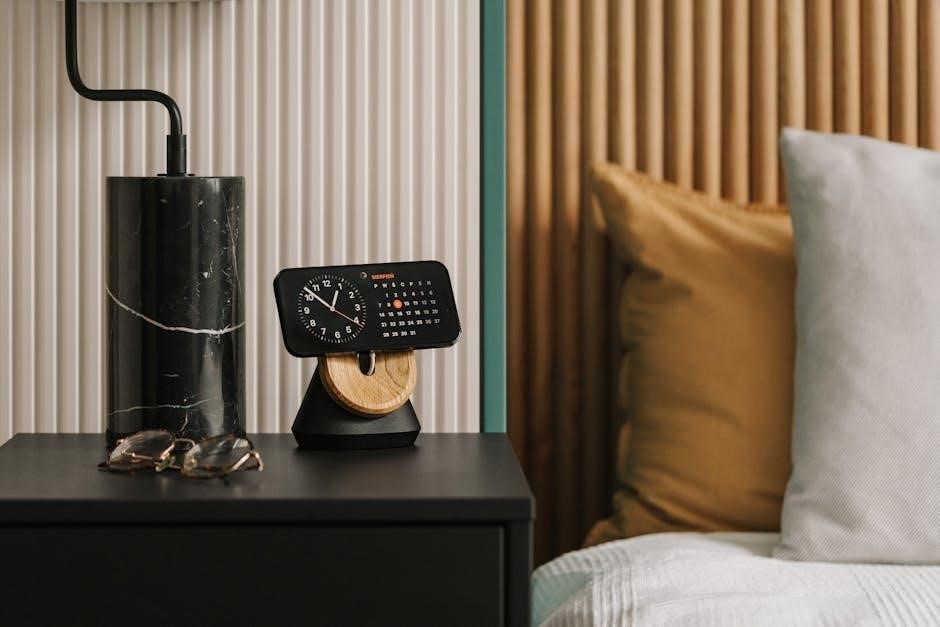Proper laser bed setup is the foundation for precise laser operations, ensuring accurate engravings and cuts by maintaining the correct alignment and level of the working surface.
Overview of Laser Bed Importance
The laser bed is a critical component in laser engraving and cutting operations, directly influencing accuracy, consistency, and safety. A properly set up bed ensures the laser head moves evenly, preventing misalignment and uneven cuts. It also protects the machine from damage by maintaining proper distance and alignment between the laser nozzle and materials. The bed’s flatness is essential for achieving precise engravings and cuts, especially when working with diverse materials like wood, metal, and plastic. A well-maintained laser bed enhances overall machine performance, ensuring efficient and high-quality results in various projects.

Safety Precautions and Preparation
Always ensure the laser is powered off and cooled down before adjusting the bed. Remove debris with a soft brush or vacuum and verify the bed’s flatness for safe operation.
Essential Safety Measures
Before starting, ensure the laser is powered off and fully cooled to prevent accidental activation. Always wear protective eyewear when working near the laser bed. Clear the work area of flammable materials and ensure proper ventilation to avoid inhaling fumes. Use a soft brush or vacuum to remove debris from the bed, preventing any obstructions during operation. Never leave the machine unattended during setup or operation, and keep emergency equipment nearby. Regularly inspect the laser head and bed for damage or misalignment to maintain safe working conditions. Adhering to these safety measures ensures a secure and efficient setup process.
Required Tools for Leveling the Laser Bed
A torpedo level, castle nut wrench, and digital angle gauge are essential for precise adjustments. Optional tools include a pin-type spanner wrench and 1-2-3 blocks for accuracy.
Tools Needed for Precise Adjustment
A torpedo level ensures the bed is perfectly flat, while a digital angle gauge provides precise angular measurements. A castle nut wrench adjusts the bed’s height, and a pin-type spanner wrench tightens or loosens components. Optional tools like 1-2-3 blocks help maintain consistent spacing and alignment. These tools are crucial for achieving accurate leveling and ensuring the laser operates efficiently. Always use them with caution and follow safety guidelines to avoid damage or injury; Proper tool utilization guarantees optimal performance and precise results in laser engraving and cutting tasks.
Leveling the Laser Bed
Loosen the bed screws and adjust each corner to ensure even alignment. Tighten screws firmly after achieving levelness. Proper leveling ensures accurate laser engravings and cuts.
Step-by-Step Leveling Process
Remove the laser bed from the foam packaging and place it inside the machine with the screw side facing up. Ensure it sits properly.
Use your hand to press each corner to check if the bed is flat. If not, adjust the bed by loosening the screws.
Tighten the screws firmly once the bed is level. Use a digital level tool to verify even alignment across all corners.
Perform a ramp test to confirm the bed is level and properly aligned with the laser head.
Finally, ensure the bed is secure and ready for operation by double-checking all adjustments.
Troubleshooting Bed Leveling Issues
If the bed does not fit the machine, check the Ruida panel settings and ensure the laser mode is set correctly. For uneven leveling, use a digital level tool to verify alignment and adjust screws as needed.
If the laser head is misaligned, place a square on the bed and check its plumbness. Use a castle nut wrench to adjust the gantry alignment.
For persistent issues, ensure the bed is perfectly flat and free from debris. If problems persist, refer to the machine’s manual for advanced troubleshooting steps.

Adjusting the Laser Head Alignment
Ensure the laser head is plumb to the bed by placing squares on the bed and sides of the head, then adjust the gantry alignment as needed.
Ensuring Proper Laser Head Positioning
Proper laser head positioning is crucial for precise engraving and cutting. Begin by ensuring the laser head is plumb to the bed using squares and alignment tools. Check the gantry’s parallelism to the bed and adjust the rails if necessary. Use the control panel to jog the head to each corner, verifying consistent height and alignment. Adjustments should be made incrementally, testing after each change to avoid misalignment. Regular checks ensure optimal performance and prevent uneven results. Proper positioning guarantees accurate laser operations and extends machine longevity.

Choosing the Right Laser Bed Type
Selecting the appropriate laser bed type depends on your material, project size, and desired durability. Glass beds offer adjustability, while honeycomb beds provide enhanced stability and heat distribution.
Comparison of Different Bed Types
When selecting a laser bed, consider materials like glass, aluminum, or honeycomb. Glass beds offer excellent adjustability and even light diffusion, ideal for precise engravings. Aluminum beds are durable and lightweight, suitable for high-volume projects. Honeycomb beds provide superior heat distribution and stability, reducing warping. Each type caters to specific needs, such as material size, weight, and thermal requirements. Choose based on your workflow, ensuring compatibility with your laser model and operational goals for optimal performance and versatility in engraving or cutting tasks.
Software Setup for Laser Operations
Configuring laser software involves setting parameters like power, speed, and focus height. Define the origin point and work area to ensure accurate engravings and cuts, optimizing your workflow.
Configuring Laser Software Parameters
Setting up software for laser operations requires defining key parameters such as power levels, pulse width, and speed to match your material and desired output. Import your design, adjust the origin point, and set boundaries for the working area. Ensure the focal length is correct for precise cutting or engraving. Some systems allow creating custom profiles for different materials, optimizing results. Advanced features like layering and raster settings can enhance detailing. Proper calibration ensures consistent and accurate laser performance across various projects, preventing errors and material waste. Regular software updates maintain functionality and compatibility with your laser equipment.

Testing and Calibration
Conduct test cuts to ensure accuracy and consistency, adjusting the focal distance and power settings as needed. Calibrate the laser bed regularly for precise engraving and cutting results.
Calibration Techniques for Accuracy
Calibration is critical for achieving precise laser results. Start with a focus test by placing a calibration card under the nozzle and adjusting the Z-axis until the laser focuses correctly. Use a ruler to measure the distance between the nozzle and the bed, ensuring it matches your material’s thickness. Perform test cuts on scrap material to verify power and speed settings. Adjust the laser head alignment if necessary to maintain consistency across the bed. Regular calibration ensures optimal performance and prevents misalignments, guaranteeing accurate engravings and cuts every time.

Maintenance and Upkeep
Regular cleaning of the laser bed ensures debris-free engraving. Use a soft brush or vacuum to remove particles. Check and tighten screws periodically to maintain flatness and secure positioning, ensuring consistent results and preventing damage to the machine.
Regular Maintenance for Optimal Performance
Regular maintenance is crucial for ensuring your laser bed performs optimally. Start by turning off the machine and allowing it to cool down before cleaning. Use a soft-bristled brush or vacuum to gently remove debris and dust from the bed surface. Avoid using harsh chemicals, as they may damage the material. Check the bed’s screws and tighten them if necessary to maintain proper alignment. Inspect the bed for wear and tear, replacing any damaged parts promptly. Additionally, ensure the bed remains flat by periodically checking its level and making adjustments as needed. This routine will extend the lifespan of your laser bed and ensure consistent, high-quality results in your engraving and cutting projects. Always refer to your machine’s specific maintenance guidelines for tailored care instructions. By adhering to these steps, you can prevent performance issues and maintain precision in your work; Regular upkeep also prevents the accumulation of residue that might interfere with the laser’s focus or accuracy. Finally, keep the surrounding area clean to avoid contamination and ensure smooth operation during each use. This consistent effort will safeguard your investment and uphold the quality of your laser projects. Regular maintenance not only enhances performance but also contributes to safety by preventing potential hazards caused by a poorly maintained bed. Stay proactive with your upkeep to achieve the best outcomes every time you use your laser engraver.




